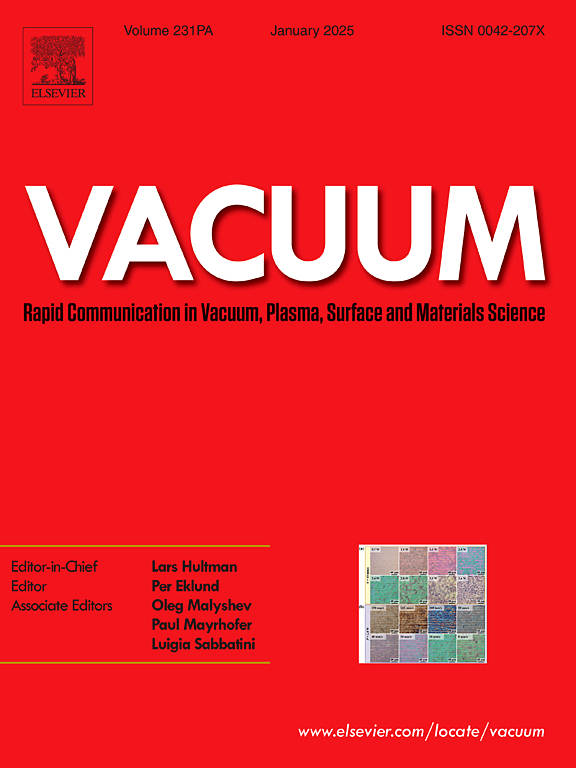Changes in electronic structure within NiSx (0.60 < x < 1.53) compound series
IF 3.8
2区 材料科学
Q2 MATERIALS SCIENCE, MULTIDISCIPLINARY
引用次数: 0
Abstract
In this article, changes in electronic properties of NiSx series of films with different sulfur content (x = S/Ni) are studied using X-ray (XPS) and ultra-violet (UPS) photoelectron spectroscopy techniques. NiSx (0.60 < x < 1.53) films are synthesized on native oxide of Si(111) substrates via reactive deposition of Ni and S in an ultra-high vacuum chamber by varying the sulfur pressures and substrate temperatures. The binding energy (BE) of Ni2p3/2 core level, the separation between the Ni2p3/2 main peaks and satellite peaks, and the Ni3d valence band binding energies are all found to vary nearly linearly with the sulfur content in NiSx series of compounds, suggesting a direct dependence of Ni electronic charge on the sulfur content. The shift of the Ni3d and S3p states (to higher and lower BE, respectively) with an increase in the S content provides experimental confirmation of the theoretical prediction previously reported (Wen et al., 2020) [1]. All NiSx films showed density of states (DOS) at the Fermi level, indicating their metallic nature. The Ni2p3/2 binding energy shift of NiSx films are much smaller than that of oxide-based compounds, confirming the significantly more covalent nature of the sulfides. NiSx film grown on Si (111) substrate showed nickel silicide interface formation. This study provides information on the growth and trends in the electronic properties of NiSx relevant for their applications in catalysis, energy storage, and electronic devices.
NiSx(0.60 < x < 1.53)化合物系列内部电子结构的变化
本文利用 X 射线 (XPS) 和紫外线 (UPS) 光电子能谱技术研究了不同硫含量(x = S/Ni)的 NiSx 系列薄膜的电子特性变化。通过改变硫压力和基底温度,在超高真空室中反应沉积 Ni 和 S,在 Si(111) 基底的原生氧化物上合成了 NiSx(0.60 < x < 1.53)薄膜。研究发现,在 NiSx 系列化合物中,Ni2p3/2 核心电平的结合能 (BE)、Ni2p3/2 主峰和卫星峰之间的间隔以及 Ni3d 价带结合能都随着硫含量的增加而几乎呈线性变化,这表明镍的电子电荷直接取决于硫含量。随着硫含量的增加,Ni3d 和 S3p 态发生了移动(分别向更高和更低的 BE 移动),这从实验上证实了之前报道的理论预测(Wen 等人,2020 年)[1]。所有 NiSx 薄膜都显示出费米级的状态密度(DOS),表明它们具有金属性质。NiSx 薄膜的 Ni2p3/2 结合能位移远小于氧化物基化合物,证实了硫化物的共价性质。在硅(111)衬底上生长的 NiSx 薄膜显示出镍硅化物界面的形成。这项研究提供了有关 NiSx 生长和电子特性趋势的信息,这些信息与 NiSx 在催化、储能和电子设备中的应用息息相关。
本文章由计算机程序翻译,如有差异,请以英文原文为准。
求助全文
约1分钟内获得全文
求助全文
来源期刊

Vacuum
工程技术-材料科学:综合
CiteScore
6.80
自引率
17.50%
发文量
0
审稿时长
34 days
期刊介绍:
Vacuum is an international rapid publications journal with a focus on short communication. All papers are peer-reviewed, with the review process for short communication geared towards very fast turnaround times. The journal also published full research papers, thematic issues and selected papers from leading conferences.
A report in Vacuum should represent a major advance in an area that involves a controlled environment at pressures of one atmosphere or below.
The scope of the journal includes:
1. Vacuum; original developments in vacuum pumping and instrumentation, vacuum measurement, vacuum gas dynamics, gas-surface interactions, surface treatment for UHV applications and low outgassing, vacuum melting, sintering, and vacuum metrology. Technology and solutions for large-scale facilities (e.g., particle accelerators and fusion devices). New instrumentation ( e.g., detectors and electron microscopes).
2. Plasma science; advances in PVD, CVD, plasma-assisted CVD, ion sources, deposition processes and analysis.
3. Surface science; surface engineering, surface chemistry, surface analysis, crystal growth, ion-surface interactions and etching, nanometer-scale processing, surface modification.
4. Materials science; novel functional or structural materials. Metals, ceramics, and polymers. Experiments, simulations, and modelling for understanding structure-property relationships. Thin films and coatings. Nanostructures and ion implantation.
 求助内容:
求助内容: 应助结果提醒方式:
应助结果提醒方式:


